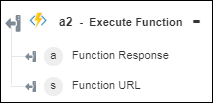Execute Function
Use the Execute Function action to execute an Azure function. This action supports HTTP triggered functions only. For more information, see Azure Functions.
Prerequisite
Before using the Execute Function action in your workflow, ensure that you create your function app on the Azure portal.
Complete the following steps to use the Execute Function action in your workflow:
1. Drag the Execute Function action under Azure to the canvas, place the pointer on the action, and then click  or double-click the action. The Execute Function window opens.
or double-click the action. The Execute Function window opens.
2. Edit the Label, if needed. By default, the label name is the same as the action name.
3. To add an Azure connector type, refer to Supported Azure Connector Types.
If you previously added a connector type, select the appropriate Connector Type, and under Connector Name, select the connector.
4. Click TEST to validate the connector.
5. Click MAP CONNECTOR to execute the action using a connector that is different from the one that you are using to populate the input fields. In the Runtime Connector field, provide a valid Azure connector name. For more information about MAP CONNECTOR, see Using Map Connector.
If you selected Connector Type as None, the MAP CONNECTOR option is not available.
6. In the Resource Group list, select the appropriate resource group defined under your Azure subscription.
7. In the Function App list, select the function app defined in your resource group.
8. In the Function list, select the function defined in the function app.
9. Under the Select Type group, click Add to add an entry and its corresponding key-value pair.
10. In the Entry list, select one of the following options:
◦ Select Query and do the following:
a. Under the Key Value Pairs group, click Add.
b. In the Name field, enter the name that you want to use in the request tag.
c. In the Value field, enter the value of the request tag.
Click Add to add multiple key value pairs. Click  to delete any key value pairs that you added.
to delete any key value pairs that you added.
◦ Select Header and do the following:
a. Under the Key Value Pairs group, click Add.
b. In the Name field, enter the name that you want to use in the request tag.
c. In the Value field, enter the value of the request tag.
Click Add to add multiple key value pairs. Click  to delete key value pairs that you added.
to delete key value pairs that you added.
◦ Select Body and do the following:
a. In the Set Body Type list, select the appropriate body type according to your content.
b. In the Content-Type list, select the appropriate content type.
c. In the Body field, enter the message that you want to send as a part of the HTTP request.
11. Click Add to add multiple entries. Click  to delete entries that you added.
to delete entries that you added.
12. Click Done.
Output schema
The output schema for the Execute Function action returns the function response and function URL.
